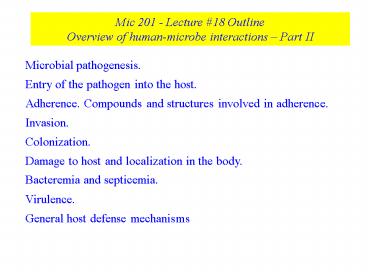Mic 201 Lecture - PowerPoint PPT Presentation
1 / 11
Title:
Mic 201 Lecture
Description:
Overview of human-microbe interactions Part II. Microbial pathogenesis. Entry of the pathogen into the host. Adherence. ... Microorganisms and pathogenesis. ... – PowerPoint PPT presentation
Number of Views:79
Avg rating:3.0/5.0
Title: Mic 201 Lecture
1
Mic 201 - Lecture 18 Outline Overview of
human-microbe interactions Part II
Microbial pathogenesis. Entry of the pathogen
into the host. Adherence. Compounds and
structures involved in adherence. Invasion. Coloni
zation. Damage to host and localization in the
body. Bacteremia and septicemia. Virulence. Genera
l host defense mechanisms
2
Microorganisms and pathogenesis. The presence and
even growth of microorganisms on the host does
not always lead to disease.
3
Microbial pathogenesis
- Entry of a pathogen into the host.
- Adherence
- Colonization
- Damage to the host
Where do most microbial infections start?
At breaks or wounds in the skin or in mucous
membranes of the respiratory, digestive or
genitourinary tract.
Specific and selective adherence. Specificity in
terms of tissue and also host.
4
Remember the polysaccharides not only involved in
adherence but in bacterial protection Capsule w
ell-defined layer surrounding the
cells. Glycocalyx loose network of
polysaccharides Slime layer diffuse mass
Remember the bacterial cell surface protein
structures such as fimbriae and pili.
Type I fimbriae of enteric bacteria.
5
Invasion
Most microorganisms have to penetrate the host in
order to trigger disease.
Lesions or small breaks but also intact surfaces
in the case of altered flora.
Colonization and growth.
Multiplication in a tissue.
Nutrient availability is indispensable. Sugars,
aminoacids, organic acids, vitamins and growth
factors, trace elements such as iron.
6
Localization in the body
First, a localized infection. After, they may
pass to lymph nodes. Eventually, spread through
blood Bacteremia the presence of bacteria in
the blood. Septicemia blood infection resulting
from the growth of a virulent organism entering
the blood from a focus of infection.
Virulence the ability of a parasite to cause
disease.
The issue of host defense
7
Host defense mechanisms
Nonspecific
Specific
Natural host resistance. Age, stress and
diet. Physical and chemical defenses. Tissue
specificity The compromised host.
8
Physical, chemical, and anatomical barriers to
infection.
9
Comparison of differences in microbial virulence
based on the number of cells of Streptococcus
pneumoniae or Salmonella typhimurium required to
kill mice.
10
Measuring virulence
LD50 ,or lethal dose 50, is the dose of an agent
that kills 50 of the animals in a test group.
Attenuated microorganisms.
11
(No Transcript)































